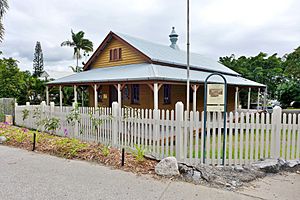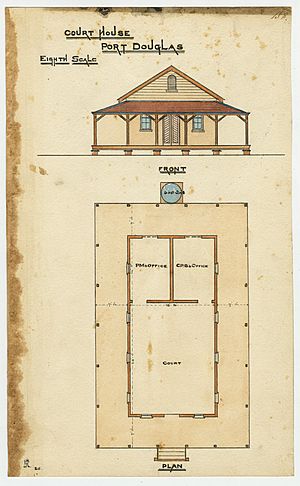Port Douglas Court House Museum facts for kids
Quick facts for kids Port Douglas Court House Museum |
|
|---|---|

Port Douglas Court House Museum, 2015
|
|
| Location | 25 Wharf Street, Port Douglas, Shire of Douglas, Queensland, Australia |
| Design period | 1870s–1890s (late 19th century) |
| Built | 1879–1911 |
| Architect | Colonial Architect's Office |
| Architectural style(s) | Classicism |
| Official name: Port Douglas Court House Museum, Port Douglas Court House | |
| Type | state heritage (built) |
| Designated | 21 October 1992 |
| Reference no. | 600465 |
| Significant period | 1870s–1880s (historical) 1870s–1910s (fabric) 1879–ongoing (social) |
| Significant components | court house |
| Builders | Thomas Watson |
| Lua error in Module:Location_map at line 420: attempt to index field 'wikibase' (a nil value). | |
The Port Douglas Court House Museum is a very old building in Port Douglas, Queensland, Australia. It was once a busy courthouse where legal cases were heard. Today, it is a museum that tells the story of the building and the local area.
This special building was designed by the Queensland Colonial Architect's Office. It was built in 1879 by Thomas Watson. The museum is now looked after by the Port Douglas Historical Society. It is an important part of Queensland's history.
A Look Back: The Court House Story
The Port Douglas Court House was built in 1879. It was the very first court house in the town. It is a simple wooden building with covered walkways, called verandahs, on all four sides.
Early Days of Queensland Courts
This court house is one of the oldest wooden court houses still standing in Queensland. When Queensland became a separate colony from New South Wales in 1859, there were only six court houses. Over the next 40 years, more than 145 court houses were built. They ranged from simple wooden structures to large buildings like the Supreme Court in Brisbane.
How Port Douglas Began
Port Douglas started to grow after gold was found on the Hodgkinson River in 1876. At first, the closest port was Cairns. But it was hard to get there because of mountains. In 1877, a bushman named Christy Palmerston found an easier path. Soon after, Port Douglas was officially named and became a port for ships.
Trade from the goldfields quickly moved from Cairns to Port Douglas. The government showed it believed in the new town. They spent money on a road to the goldfields. They also built many public buildings, including the court house.
The Need for a Proper Court House
The first Police Magistrate (a type of judge) arrived in Port Douglas in 1878. At first, court sessions were held in a police cell, which was not ideal. Then, a tent was used for most of 1878. Later, the court moved into the new Customs House. As more people came to Port Douglas, it became clear that a special building was needed just for the court.
When Port Douglas was planned, land was set aside for the Court House. But a building was already there. So, the court house was built across the street instead.
Designing and Building the Court House
The building was designed by the Colonial Architect's office. They made sure it would work well in the local climate. The main part of the building had the court room at the front. There were two offices at the back. Verandahs surrounded the whole building.
Thomas Watson, a builder from Brisbane, won the contract to build it. He had experience building similar court houses. Construction began in September 1879 and finished in November. The cost was £475.
Changes and Upgrades Over Time
- In 1880, a part of the verandah was enclosed. This created a small room for juries to use.
- Later, this jury room was made bigger.
- Over the years, parts of the verandah floor and the wooden stumps supporting the building had to be replaced. This was due to weather damage and white ants (termites).
The Cyclone of 1911
In March 1911, a powerful cyclone hit Port Douglas. It badly damaged the court house. The roof was partly blown off, and the building was knocked off its stumps. Some stumps even poked through the floor!
After the cyclone, the building was repaired and changed a lot. It was even turned to face Wharf Street differently. A separate room was added at the back for police use. These changes were so big that the project was called "New Court House, Port Douglas."
Later Years and Important Cases
After 1911, only small repairs were done. In 1958, the wooden walls had shrunk, letting light shine through. So, the court and judge's rooms were lined with hardboard.
The building's simple design was very successful. It was used for many court houses in Queensland until the 1930s.
The Port Douglas Court House was mainly for court sessions. But it was also used for police offices. For a short time, it was even home to the town's only police officer. Most cases were small. However, one very serious case happened there in 1886. A woman named Ellen Thompson faced a very serious legal outcome. She was the only woman to receive such a punishment in Queensland.
Moving and Returning Home
The court house stopped being used in 1961. People in the community worked hard to save the building. In 1968, it was sold and moved to the grounds of the Court House Hotel.
Sadly, the old police cells next to it were destroyed by a falling tree. A fire also damaged the former police offices. But in 1993, the Court House was moved back to its original spot. It was placed exactly where it stood when first built.
Since April 1997, the building has been a museum. The Douglas Shire Historical Society created it. The museum shows exhibits about the court house's history and the local area.
What the Museum Looks Like
The Port Douglas Court House is a simple wooden building. It has a rectangular shape with verandahs on all four sides. It stands on low wooden stumps and has a gabled roof made of corrugated iron.
Today, it is back in its original place, facing Wharf Street. It sits in a lovely park-like area near the water.
The verandah roof is separate from the main roof. It is held up by wooden posts with simple diagonal braces. You enter the building through stairs at the front. These lead to two wooden doors. On either side of the doors are windows with four glass panes.
Inside, the building has three rooms. The main court room is at the front. There is a smaller room at the back. A tiny room in the corner of the front room can only be reached from outside.
Many of the original parts of the building are still there. However, some sections have been rebuilt over time.
Why It's a Heritage Site
The Port Douglas Court House Museum was added to the Queensland Heritage Register on 21 October 1992. This means it is a very important historical place.
Showing Queensland's History
The court house was built in 1879. It shows how quickly Port Douglas grew after gold was found nearby. As an early government building in far northern Queensland, it helps us understand the development of the state.
A Rare and Special Building
This building is rare because it is one of the few wooden buildings from before the 1880s still standing in North Queensland. It is the oldest building in Port Douglas. It is also the second oldest wooden court house in all of Queensland.
A Great Example of Its Kind
The Port Douglas Court House shows what court houses in regional towns looked like during Queensland's early development. It is a good example of how these important public buildings were designed.
Beautiful to Look At
The building has a lot of aesthetic significance. This means it is beautiful to look at. It has a simple, balanced design and is set in a lovely park near the ocean.
Important to the Community
This place is very important to the local community. People worked hard to keep the building on its original site. They were key in getting it moved back home. Now, a local community group takes care of the museum.


